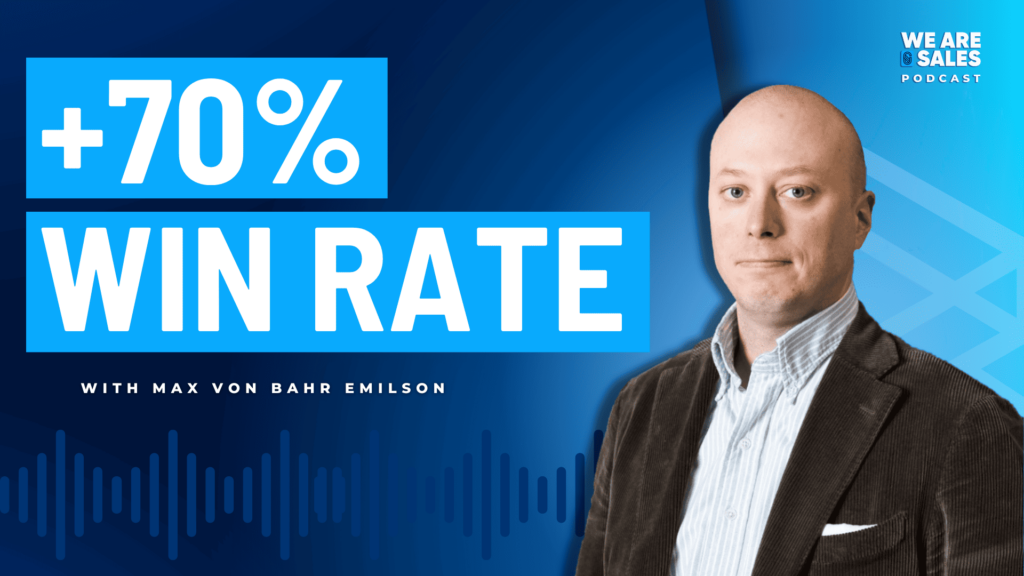Share:
The system that enabled TrueLayer to achieve a 50-75% win-rate

Achieving a 50-75% win-rate in sales might sound like a lofty ambition, but for TrueLayer, it’s a reality. In this article we’ll highlight the 7 cornerstones of the verticalized system that made it possible for TrueLayer to achieve this feat.
Set the scene
TrueLayer is at the forefront of the open banking payments network, seamlessly integrating real-time bank payments with financial and identity data. An important aspect of the business model is that they earn money per transaction.
Therefore, they are dependent on transaction volume, which makes big enterprise companies their ICP, the bigger the better. Secondly, Truelayer’s solution is complicated, making the implementation a complex process. As a result of this long sales cycle and lengthy implementation, the pay-back of the GTM-motion is incredibly long.
“It’s very hard to gain the feedback from the market. Going into a vertical with a new product, with a new set of customers, it takes 2 years to test if this vertical is viable or not.”
This complex & unique environment also needs a particular GTM organisation. When Max joined TrueLayer 4 years ago, they made the decision to change the GTM organisation from a generalistic and siloed organisation to a verticalized one.
Each vertical is a specific target group or industry. Each vertical has a vertical leader who has a team with marketing, sales, implementation and customer success people that only work on customers within that vertical.
1. Verticalization only works with the right people
As often echoed by leaders, success depends on hiring the right individuals. In the case of TrueLayer this was even more important, due to the complexity of the markets they operate in and the unique nature of their organisational structure. Interestingly he also makes a big destinction between his hiring process of vertical leaders and individual contributors (IC).
“I’m incredibly picky with the vertical leaders, on average it took 2 years to hire the right leader for each vertical”
Especially on the leaders Max is incredibly picky, he only hires great leaders. They must possess prior experience in selling similar technologies to the same customer profile within their respective verticals. This domain knowledge is pivotal in understanding customer needs and strategic focus areas. These profiles are so difficult to find that it takes on average 2 years to hire the right profiles in leadership positions.
To distinguish between average and exceptional leaders, Max points out that an average leader that enters the organisation just randomly probes the market. On the other hand, exceptional leaders come in with 3 hypotheses and will test these in the market. Also, great leaders see where the problems and chances are and therefore knows where his team should focus.
Max illustrated this with a recent example they experienced, when they hired a vertical leader that was previously leading the enterprise sales division at PayPal.
“After being at TrueLayer for only 1 week, it felt like he was already here for 6 months. He instantly identified the 4 aspects the team had to focus on, in order to be successful in the vertical. Knowing that the team tried to get into this vertical for already 4 years, having to wait 2.5 years to find this leader, was completely worth it.”
Interestingly, for the ICs the experience is more of a nice-to-have, than a requirement. For them it’s all about having the right mindset and a high level of intelligence. The vertical expertise is developed after joining TrueLayer. They gain expertise within their vertical over time, ultimately becoming the trusted advisors that set TrueLayer apart.
Now the vertical is formed we can take a look into how the mechanics of these verticals allow TrueLayer to beat their competitors.
2. Why vertical teams win
The vertical leader is crucial in the way the vertical approaches the market, you can see the vertical leaders as the CEOs of their own companies.
We already touched on the parts of each vertical namely marketing, sales, customer success and implementation. Nevertheless, each vertical can have its distinct commercial team structure. For example, it’s possible that in one of the verticals the implementation team is needed in the beginning of the sales cycle, whereas in another vertical they only come into the picture once the deal is closed.
Besides the control over the structure of the commercial teams, the vertical leader is also able to tweak the KPIs if needed. First of all, the whole vertical has the same KPI, which creates alignment within the team. Next, the KPI of each team varies based on the maturity of the vertical they’re active in. For instance, in an early stage vertical the KPI is the amount of created opportunities & in a mature vertical the KPI will be the amount of revenue generated. It’s the job of the vertical leader to set the right KPIs at the right time.
Thanks to the teams’ size, adaptability, and alignment, they can move swiftly and excel in the targeted verticals. However, choosing the right vertical is equally crucial.
3. The right vertical is crucial for success
Identifying the right vertical is a make-or-break decision. It takes about 2 years to judge if a vertical is a success, therefore it’s incredibly important to pick the right vertical. Being data driven is certainly important.
“It’s key that the SAM & TAM are big enough, but it’s not the deciding factor in judging if a vertical presents a big enough opportunity.”
In Max’s opinion almost every vertical is big enough, as long as you win the vertical.
To Max there is another variable which is way more important – the “readiness to buy” of a vertical. Signals of willingness to buy are identified from past customer calls, providing insights into the verticals where decisions are actively being made.
“If my win-rate is 50-75%, my problem is not winning the deal, my problem is – How many customers are making decisions. I need decision, whether they are ‘yes’ or ‘no’, I need decisions”
Once the intention is detected, TrueLayer places an AE on this vertical that engages with 10 customers, validating the signals and the viability of pursuing that vertical.
Once per quarter the leadership team sits together with the vertical leaders and product, go over the results of the past quarter and discuss on which verticals they will double down.
4. When is a vertical successful?
Once decided to double down on a vertical, the real challenge begins. In the first 6 months sales talks to 50 customers and generates quality leads. The lead size is less critical at this stage, given the vertical’s unproven nature.
“I don’t want to see €100M leads in the pipeline. I want to see 100 leads. Later on, we’ll be able to put a monetary valuation to the pipeline but at the beginning it’s too early to do so.”
Over the next 6 months, the goal shifts to closing deals to validate the conversion of leads into customers.
Once the deal is closed, the sales cycle does not stop there. Now it’s time to make sure that these new customers use the product and calculate the ROI of the product in this new vertical. In total it takes around 2 years to prove the success and viability of a vertical. Once this is proven it’s time to triple down on the vertical.
5. Leveraging FOMO
By now it should be clear that entering a new vertical is not that straight forward. Luckily it gets easier after you close the first client.
“In a vertical, going from 0 to 1 customer is 10 times harder than going from 1 to 10 customers.”
Once you close the first client it’s time to play on FOMO (Fear Of Missing Out). Competitors closely watch each other, and when one adopts innovative technology, others follow suit to stay competitive.
TrueLayer strategically leverages PR initiatives, showcasing deals with important players in a vertical. This not only attracts spontaneous interest from competitors but also creates FOMO for potential prospects, pushing them to adopt the technology.
6. The key to product adoption
During the interview one important aspect kept coming back: product usage is the lifeblood of TrueLayer’s revenue model.
The commission system reinforces the importance of closing quality deals and ensuring active product usage. The team earns commissions solely based on actual product usage, not projections. This system creates a sense of accountability within the commercial activities of the vertical teams, from identifying quality leads to successful customer adoption.
This alignment on all aspects takes away the typical blame game that usually tends to happen in a siloed commercial team.
7. The Power of Assuming Positive Intent
Even though the whole system is designed to avoid blaming, shared accountability can sometimes still lead to finger-pointing and blame within teams when targets aren’t met. To counteract this, Max advocates adopting the principle of assuming positive intent, found in the book: “The 5 dysfunctions of a team”. This approach assumes that coworkers act in the best interest of the team, resolving conflicts more effectively.
“The assumption of positive intent, solves 9 out of 10 conflicts within the team.”
To strengthen this mindset, -physical team interactions and vulnerability are encouraged, starting from the leadership level.
Navigating the challenges
The verticalized model presents challenges, primarily the cost of assembling specialised teams for each vertical. Hiring experts in specific domains can be expensive and challenging due to limited talent pools.
Besides that, the verticalized system doesn’t allow to standardise certain processes, which adds to the expenses. Finally the extended timeline required to validate a vertical’s profitability means that investments might be done in vain if a vertical turns out to be unviable.
A second challenge of the verticalized model is the question of which functions to include in the verticals and which functions stay in the centralised organisation. Max acknowledges that this remains an area of focus for the leadership team. For example – Max would love to include product and engineering in the verticals, but this hasn’t been implemented yet.
The future of this system – When to go back to the traditional organisation
The moment the company becomes mainstream & everyone knows what open banking is, it’s time to step away from the verticals and go back to a more general commercial organisation system. Scaling a general revenue organisation is simpler compared to scaling verticals. However, in the short to medium term, TrueLayer plans to launch more verticals tailored to specific countries and industries.
Conclusions
Deploying a verticalized system is a decision that you don’t take overnight. It’s a complete overhaul of the structure of your organisation that has a big impact on your day-to-day operations. However if you decide to do the change, this article can help you on the way. If you want to get even more information, you can listen and/or watch the full interview below.

